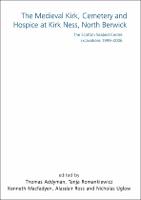The Medieval Kirk, Cemetery and Hospice at Kirk Ness, North Berwick
| dc.contributor.author | Addyman, Thomas | |
| dc.contributor.author | Macfadyen, Kenneth | |
| dc.contributor.author | Romankiewicz, Tanja | |
| dc.date.accessioned | 2022-03-18T05:31:16Z | |
| dc.date.available | 2022-03-18T05:31:16Z | |
| dc.date.issued | 2013 | |
| dc.identifier | OCN: 1317832049 | |
| dc.identifier.uri | https://library.oapen.org/handle/20.500.12657/53432 | |
| dc.description.abstract | Between 1999-2006 Addyman Archaeology carried out extensive archaeological excavations on the peninsular site of Kirk Ness, North Berwick, during the building, landscaping and extension of the Scottish Seabird Centre. This book presents the results of these works but its scope is much broader. Against the background of important new discoveries made at the site it brings together and re-examines all the evidence for early North Berwick – archaeological, historical, documentary, pictorial and cartographic – and includes much previously unpublished material. An essential new resource, it opens a fascinating window on the history of the ancient burgh. Kirk Ness is well known as the site of the medieval church of the parish and later royal burgh of North Berwick but it has long been suggested that it was also a centre of early Christian activity. The dedication of the church to St Andrew was speculatively linked to the translation of the Saint's relics to St Andrews in Fife in the 8th century. An early medieval component of the site was indeed confirmed by the excavation, with structural remains, individual finds and an important new series of radiocarbon dates. Occupation of a domestic character may possibly reflect a monastic community associated with an early church. Individual finds included stone tools, lead objects, ceramic material and a faunal assemblage that included bones of butchered seals, fish and seabirds such as the now-extinct Great Auk. The site continued in use as the medieval and early post-medieval parish and burgh church of St Andrew. In this period Kirk Ness and its harbour was an important staging point for pilgrims on route to the shrine of St Andrew in Fife. Domestic occupation discovered in the excavations is likely to be associated with a pilgrims’ hospice, also suggested in historical sources. This publication also provides a new analysis of the church ruin and an account of the major unpublished excavation of the site carried out in 1951-52 by the scholar and antiquary Dr James Richardson, Scotland's first Inspector of Ancient Monuments and resident of North Berwick. The excavations also revealed areas of the cemetery associated with the church, dating to the 12th–17th centuries, where inhumations presented notable contrasts in burial practice. Osteological study shed much light upon the health and demographics of North Berwick’s early population and identified one individual who met with a particularly violent death. | |
| dc.language | English | |
| dc.subject.classification | thema EDItEUR::N History and Archaeology::NK Archaeology | en_US |
| dc.subject.classification | thema EDItEUR::N History and Archaeology::NH History::NHD European history | en_US |
| dc.subject.other | Social Science | |
| dc.subject.other | Archaeology | |
| dc.subject.other | History | |
| dc.subject.other | Europe | |
| dc.subject.other | History | |
| dc.subject.other | Europe | |
| dc.subject.other | Medieval | |
| dc.title | The Medieval Kirk, Cemetery and Hospice at Kirk Ness, North Berwick | |
| dc.type | book | |
| oapen.relation.isPublishedBy | dc03c27f-26a0-45f6-87b5-57bf794f24c1 | |
| oapen.relation.isFundedBy | b818ba9d-2dd9-4fd7-a364-7f305aef7ee9 | |
| oapen.relation.isbn | 9781789258899 | |
| oapen.collection | Knowledge Unlatched (KU) | |
| oapen.imprint | Oxbow Books | |
| oapen.identifier | https://openresearchlibrary.org/viewer/8dd5e54c-ec69-467c-b8e3-686faa76b868 | |
| oapen.identifier.isbn | 9781789258899 |

